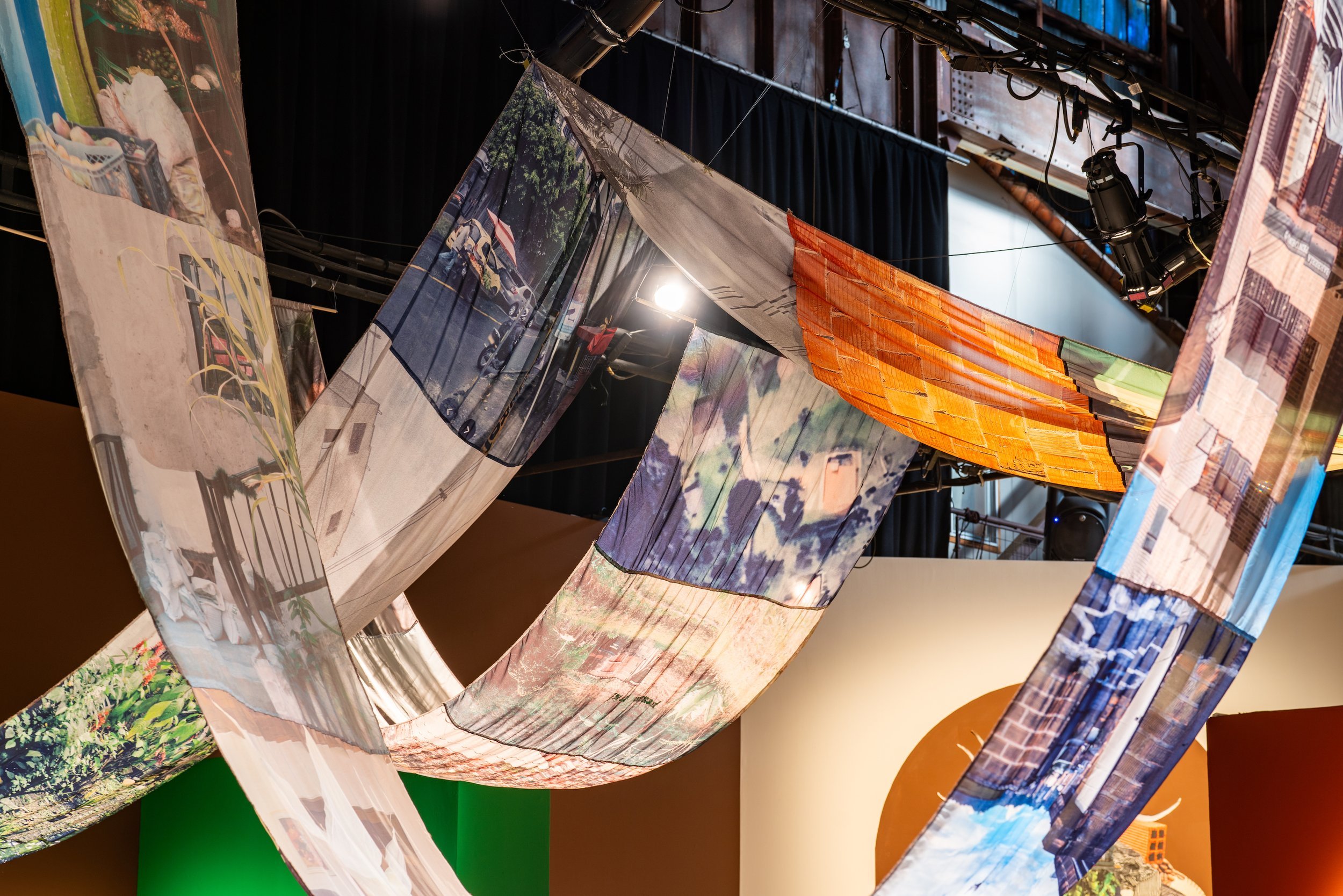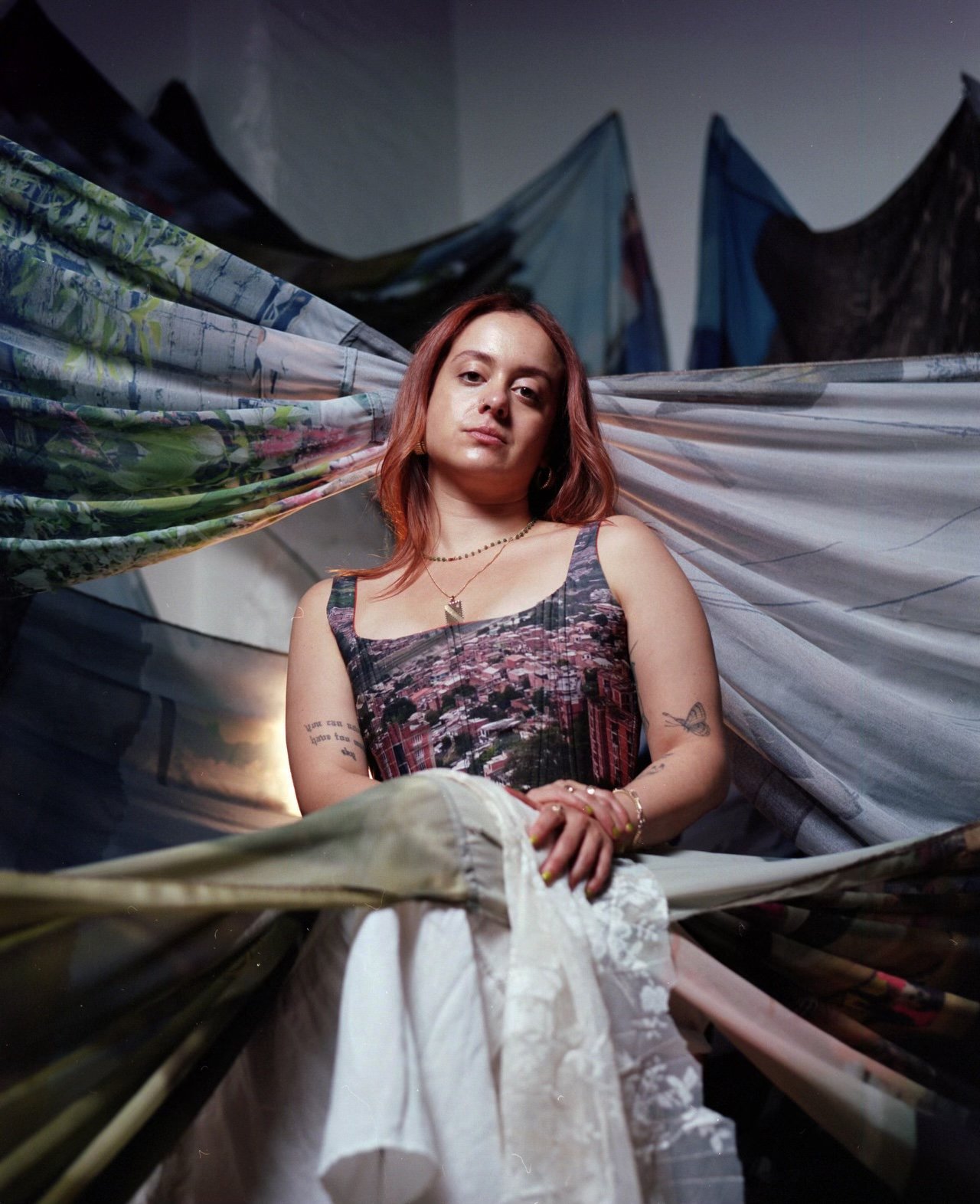Paola de la Calle’s Threads of Memory and Resistance
In the third interview of The Psychic Landscape series, artist Paola de la Calle delves into the origins of her work — exploring archives, popular graphics, street art, muralism, and food justice — which all significantly contribute to her practice of remembering and unraveling established narratives.
From textiles to printmaking, Paola's versatile use of mediums creates a visual language. 'Todo el cielo cabe en la maleta' (The whole sky fits in a suitcase), a sculpture featuring found objects and printed cotton, comes to NYC Culture Club this February alongside works by Francisco Donoso, Kathryn Godoy, Elsa Muñoz, and Marisol Ruiz. With it, Paola explores the intangible aspects of migration:
‘In my dreams I visit places that no longer exist and I wonder if you visit them too and if so are dreams memories too?’
In this interview with co-curators Veronica Petty and Francisco Donoso, Paola emphasizes the importance of specificity in addressing diverse experiences within Latinx art. Her work, rooted in nostalgia, lays the foundation for a nuanced exploration of memory, migration, and identity.
Paola de la Calle (she/her) is a Colombian-American multidisciplinary artist whose work examines home, identity, borders, and nostalgia through the use of textiles, printmaking, and sculpture. In her practice, De la Calle combines photographs sourced from family albums and found images which she prints on textiles, as well as poetic texts, paintings made with coffee instead of paint, and found objects, to mine the aesthetics of nostalgia and examine the socio-political relationship between the United States and Colombia.
Paola, the work 'Hanging Archive' confronts the silences and erased histories of Latin America, and we're proud to showcase it in New York for the first time after its debut at SOMARTS in San Francisco this summer. Could you offer insights into the background of this artwork and shed light on the imagery and your creative process in its creation?
I like to think that “Hanging Archive” is a work that predates me and will continue to grow over time. I say this because “Hanging Archive” developed in the preliminary stages of planning my first solo exhibition, In This House We Are All Buried Alive, while I was conducting historical research. It was through the act of digging through digital archives on Spanish Colonization, the War on Drugs and Colombia that I began to see a pattern emerge and a pattern I wanted to interrupt. Archives are not neutral, they tell incomplete stories from a specific perspective. I consider “Hanging Archive” my way of not just responding to the archives I found, which perpetuate narratives of violence, but complicating the idea of what belongs in an archive. The piece is made of personal film photographs I took with my 35mm camera, video stills from home videos shot between 1990 and 2008, WhatsApp messages, and screenshots from Google Map searches printed on delicate chiffon fabric – that choice was deliberate. Chiffon is translucent and easy to tear, to me it’s reminiscent of a memory. An archive is considered a place that collects evidence, facts, and data, but what’s acquired or considered important enough to include in an archive is based on the judgment of the archivist and the objects that have survived. The choice to include or exclude becomes part of the historical memory of a country. To create a work that will continue to grow over time is also a statement that’s rooted in my belief that archives should expand and evolve through time, not remain stagnant. The scale of the work invites participation, for the viewer to walk through, around, and under the “archive”, for the viewer to become part of the work.
Hanging Archive, Chiffon with embroidery, 2023
In your recent interview with Refinery29, you emphasized the significance of art in addressing themes of forced migration and the impact on families. Can you share specific examples from the work we’ll see as part of the 'The Psychic Landscape' exhibition where you continue to engage with these themes, and the messages you aim to convey within the context of the show?
Something that I’m critical of is the common narrative that migration is a choice, particularly when discussing migrants from countries where U.S intervention and foreign policy has destabilized their government, exploited their land, and funded wars. Nothing exists in a vacuum. So in my practice I’m threading together the past and present to better understand the socio-political relationship between two countries I call home, to better understand myself, and to contextualize the family stories that make their way into my art. In “Todo El Cielo Cabe En Una Maleta” (or “The Whole Sky Fits in a Suitcase’”) I’m exploring the idea of “envios” or “encargos”, but I’m not just exploring the material goods we send across borders, but the intangible as well. The embroidered text on the suitcase reads: In my dreams I visit places that no longer exist and I wonder if you visit them too and if so are dreams memories too? I wrote that phrase in my journal after waking up from a dream where I was in a place I’d never been, but felt familiar with people who were familiar, but aren’t here anymore. While making it I was thinking about how we make memories with loved ones across borders and the suitcase being a vessel for connection.
You're so versatile, working with textiles, printmaking, sculpture, and more. How do all these tools help you express your ideas and emotions, especially in the context of this exhibition?
Material matters. The medium or material I utilize is typically the first part of the artwork a viewer can use to begin to understand the message in the work in front of them. Picking which medium I’ll use to translate an idea into its physical form is usually the first step in my process, after filling a few pages of my sketchbook with notes and timelines and rough thumbnail sketches. It’s part of my visual language and the way I untangle ideas in my practice. I attach meaning to objects and to the mediums I work with, printmaking is political, coffee is reminiscent of home, but also a conversation on exportation and exploitation, iron refers to memory or ephemerality, textiles are embedded in my practice as a way to honor the women who came before me, as a way to consider the passing of knowledge and tradition. In the words of Hank Willis Thomas, “I have to work in different mediums, I have to try different ways to look at something”
Todo el cielo cabe en la maleta (The whole sky fits in a suitcase), Suitcase sculpture with found objects and printed cotton, 24” x 18” x 21”, 2023
You know I've always been such a fan of how you capture those small details in your work, the ones that resonate so deeply with Colombian Americans like us, and the experiences of growing up with Colombian parents in the US. How do you envision your work in nostalgia being perceived in an art historical context, especially as the world becomes more homogenized? How might it resonate with future generations of Latinx individuals who have different experiences and perspectives?
I think it’s important to be specific and as I’ve matured in my practice specificity is what keeps me grounded. Right now we’re seeing Latinx art be defined under broad strokes in an attempt to capture the experiences and identities of people of different races, from different countries, who speak different languages, practice different religions, and so on. I hope in the future there is space for Latinx art to exist beyond the confines of what's deemed acceptable, beyond notions of labor, migration, and “ni de qui, ni de alla”-ities we see so often. In terms of how my work will be perceived in the future, I think only time will tell. In my personal life I’m working on letting go of my need to control or predict the future, so for now I’ll bring that lesson into my art practice and just say lo que será, será.
Your exhibition 'In This House We Are All Buried Alive' (SOMARTS) drew inspiration from María Mercedes Carranza's poem 'La Patria' and explored the intricate relationship between power and memory. How does your art investigate the impact of the social-political histories of the United States and Colombia on family narratives, identity, and cultural memory, and how does it resist the institutionalizing of historical amnesia?
To understand my exploration of the relationship between memory and power it’s important to understand the origins of my work, that is, where my ideas materialize. I’m interested in archives, what makes it into an archive, but also their necessity and existence. I’m interested in grafica popular or “popular graphics”, the iconography that defines a region, street art, and muralism and its connection to resistance movements. I’m interested in food justice and the politics behind food, specifically bananas because of my familial ties to banana farms in Colombia. I consider my practice a constant act of remembering, of sewing threads together between two places, ideas, or moments in time, but almost simultaneously unraveling what we already understand to investigate further and ask questions about what is missing from the narrative we are presented with.
Thank you Paola, for offering such insightful reflections and background on the work we'll have the fortune of experiencing firsthand in just over a week.
Some key takeaways from the interview that we hope will stay in mind when visiting The Psychic Landscape this February include Paola’s ability to let her meticulous choice of medium emerge as a storyteller. From politically charged printmaking to the warmth of coffee's reminiscence, each medium serves as a vessel for memory.
We're beyond grateful for the opportunity to bring these pieces to New York City after their successful debut at San Francisco’s SOMArts and believe they will resonate deeply with viewers here.
Join us February 1 - March 3, 2024 — at the Opening Reception on Thursday, February 1, 6-9 pm — NYC Culture Club, World Trade Center, Oculus, C1 Level, South Concourse, 185 Greenwich Street.



